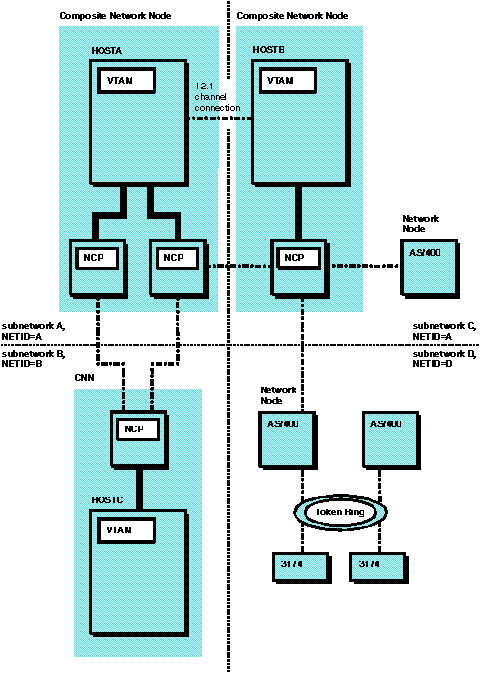 z/OS Communications Server: SNA Network Implementation Guide
z/OS Communications Server: SNA Network Implementation Guide
 z/OS Communications Server: SNA Network Implementation Guide
z/OS Communications Server: SNA Network Implementation Guide
|
Previous topic |
Next topic |
Contents |
Contact z/OS |
Library |
PDF
APPN multiple network connectivity z/OS Communications Server: SNA Network Implementation Guide SC27-3672-01 |
|
|
APPN multiple network connectivity support enables connectivity between APPN networks, without the exchange of topology information between the networks. APPN multiple network connectivity support may exist between APPN networks that have different network IDs, and also between APPN subnetworks that have the same network ID. APPN multiple network connectivity support can also be used with High-Performance Routing (HPR) support to enable HPR routes between nodes in different subnetworks. See High-Performance Routing (HPR) for information about HPR support. APPN multiple network connectivity support uses border nodes at the boundaries between APPN networks or subnetworks. With APPN multiple network connectivity support, full APPN directory and session initiation support is available across these boundaries. APPN directory search activity can be managed through several user-definable parameters for border nodes. Class of Service definitions do not need to be consistent across network or subnetwork boundaries, allowing for independent management. APPN multiple network connectivity support enables you to eliminate topology exchange between APPN networks or subnetworks when the exchange of such data is undesirable (for example, for networks of different enterprises). Topology exchange is eliminated between border nodes. This way, you can protect smaller subnetworks from the volume of topology in a larger subnetwork or from processing searches for resources that do not exist in the smaller subnetwork. Thus, APPN multiple network connectivity support can be used to manage the increase in topology and directory search activity as an APPN network grows. For example, the APPN network in Figure 1 is divided into four subnetworks. With APPN multiple network connectivity support, full APPN directory and session initiation support is available across all subnetwork boundaries, and yet, the creation of smaller subnetworks protects each from the volume of topology and search processing that would exist in the entire APPN network (which could, of course, extend beyond what is shown). Figure 1. APPN subnetworks through APPN multiple network
connectivity support
 There are two types of border node boundaries:
Restriction: APPN multiple network connectivity
support cannot be used to connect two APPN networks or subnetworks
through a connection network unless the connection network uses
Enterprise Extender and is defined as VNTYPE=GLOBAL. For more information,
see Configuring the EE connection network.



|
 Copyright IBM Corporation 1990, 2014 Copyright IBM Corporation 1990, 2014 |